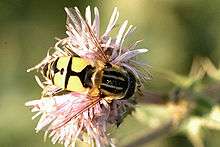Helophilus hybridus
Helophilus hybridus is a hoverfly.[1] It is a Palearctic species.
| Helophilus hybridus | |
|---|---|
 | |
| Scientific classification | |
| Kingdom: | |
| Phylum: | |
| Class: | |
| Order: | |
| Family: | |
| Subfamily: | |
| Tribe: | |
| Genus: | |
| Species: | H. hybridus |
| Binomial name | |
| Helophilus hybridus Loew, 1846 | |
Description
For terms see Morphology of Diptera
Wing length 8·5-11·25 mm. Femorae 3 top 1/4 or less yellow. Tibiae 3 pale on basal 1/4 or less. Males tergite 2 large yellow spotsreach the hind margin over their full width. The larva is illustrated by Hartley (1961).[2] See references for determination [3][4][5][6]
Distribution
Palearctic Fennoscandia South to North France. Ireland East through North Europe and Central Europe (including the Alps) East into Russia and on through the Russian Far East and Siberia to the Pacific coast. Mongolia. Nearctic from Alaska to Nova Scotia and South to Utah.[7][8]
Biology
Habitat: wetlands non-eutrophic pools in fen, poor fen, deciduous woodland and dune slacks, cutover valley bog, fen carr, taiga.[9] Flowers visited include white umbellifers, Calluna vulgaris, Cirsium, Convolvulus, Crataegus, Echium, Euphorbia, Limonium, Lycopus, Mentha aquatica, Menyanthes, Narthecium, Parnassia palustris, Plantago, Pulicaria, Rosa, Rubus, Salix repens, Salix, Senecio, Sorbus, Succisa, Taraxacum, Valeriana.[10] The flight period is early May to early September.
References
- Stubbs, Alan E.; Falk, Steven J. (1983). British Hoverflies: An Illustrated Identification Guide. British Entomological & Natural History Society. pp. 253, xvpp.
- Hartley, J.C. (1961) A taxonomic account of the larvae of some British Syrphidae. Proc.zool.Soc.Lond.,136: 505-573.
- Van Veen, M. (2004) Hoverflies of Northwest Europe: identification keys to the Syrphidae. 256pp. KNNV Publishing, Utrecht.addendum
- Van der Goot,V.S. (1981) De zweefvliegen van Noordwest - Europa en Europees Rusland, in het bijzonder van de Benelux. KNNV, Uitgave no.32: 275pp. Amsterdam.
- Bei-Bienko, G.Y. & Steyskal, G.C. (1988) Keys to the Insects of the European Part of the USSR, Volume V: Diptera and Siphonaptera, Part I. Amerind Publishing Co., New Delhi. ISBN 81-205-0080-6.
- Coe, R.L. (1953) Diptera: Syrphidae. Handbks.ident.Br.insects, 10(1): 1-98. R.ent.Soc.London. pdf
- Fauna Europaea
- Peck, L.V. (1988) Syrphidae. In: Soos, A. & Papp, L. (eds.) Catalogue of Palaearctic Diptera, 8: 11-230. Akad.Kiado, Budapest.
- Speight, M.C.D. (2011). "Species accounts of European Syrphidae (Diptera)" (PDF). Syrph the Net, the database of European Syrphidae. 65: 285pp.
- de Buck, N. (1990) Bloembezoek en bestuivingsecologie van Zweefvliegen (Diptera, Syrphidae) in het bijzonder voor België. Doc.Trav. IRSNB, no.60, 1-167.